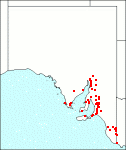Family: Asteraceae
Senecio tenuiflorus
Citation:
Sieber ex Schultz-Bip., Flora 28:498 (1845).
Synonymy: Erechtites tenuiflora DC., Prod. 6:296 (1838); S. apargiaefolius Walp., Linnaea 14:309 (1840); E. apargiaefolius (Walp.) Sonder, Linnaea 25:524 (1853); S. hispidulus x quadridentatus: Belcher, Ann. Miss. Bot. Gard. 43:71 (1956), partly.
Common name: None
Description:
Erect or ascending annual or biennial herb, 30-60 rarely 100 cm high; branches basal or only in the inflorescence; root system fibrous, often fleshy; lower leaves crowded, obovate to oblanceolate, 4-10 x 1-2.5 cm, obtuse, denticulate to serrulate, subpetiolate above a shortly clasping base, moderately to densely hispid beneath, with multicellular tapering hairs terminating in long filaments, cobwebby to somewhat scabrous above; mid-stem leaves similar, shorter, lanceolate.
Inflorescence laxly corymbose-paniculate, of 20-40 capitula; peduncles 15-25 mm long, cottony; involucres narrowly cylindrical, 7.5-9 x 2-3.5 mm; bracts 9-13; calyculus of 3-5 narrowly triangular bracteoles; female florets 14-40, 3- or 4-lobed; bisexual florets 8-15, 5-lobed.
Achene 2.2-2.5 x 0.5-0.6 mm, plump, not at all attenuate-rostrate apically, red-brown, minutely hairy in the narrow grooves, ribs flat, not prominent; pappus deciduous, dimorphic.
|
|
Distribution:
|
In disturbed areas, on roadsides, and in open woodlands; on sandy and sandy clay soils in moist settings, often accompanying S. quadridentatus.
W.Aust.; Qld; N.S.W.; Vic.; Tas.
|
Conservation status:
native
Flowering time: Oct. — Jan.
|

SA Distribution Map based
on current data relating to
specimens held in the
State Herbarium of South Australia
|
Biology:
Resembles S. quadridentatus (fig. 727H) in habit. Positively distinguished by characters of the achenes, and by the involucral bracts typically each with a single (sometimes dual) prominent vein and few or no minor ones (visible only after the use of a clearing agent such as lactic acid).
Author:
Not yet available
|

